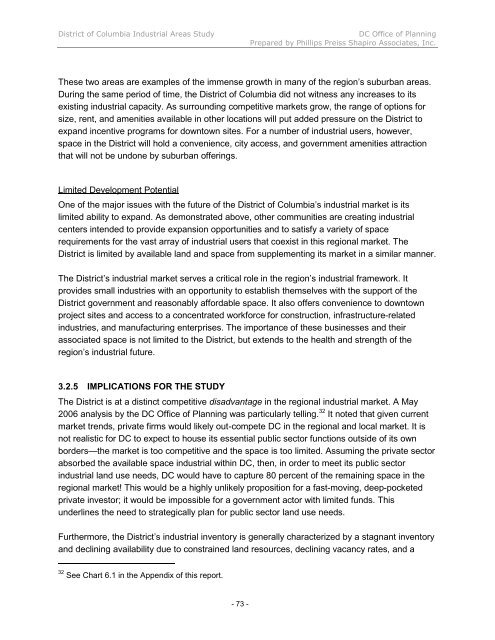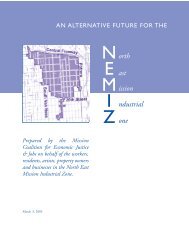INDUSTRIAL LAND IN A POST-INDUSTRIAL CITY District of ...
INDUSTRIAL LAND IN A POST-INDUSTRIAL CITY District of ...
INDUSTRIAL LAND IN A POST-INDUSTRIAL CITY District of ...
You also want an ePaper? Increase the reach of your titles
YUMPU automatically turns print PDFs into web optimized ePapers that Google loves.
<strong>District</strong> <strong>of</strong> Columbia Industrial Areas Study DC Office <strong>of</strong> Planning<br />
Prepared by Phillips Preiss Shapiro Associates, Inc.<br />
These two areas are examples <strong>of</strong> the immense growth in many <strong>of</strong> the region’s suburban areas.<br />
During the same period <strong>of</strong> time, the <strong>District</strong> <strong>of</strong> Columbia did not witness any increases to its<br />
existing industrial capacity. As surrounding competitive markets grow, the range <strong>of</strong> options for<br />
size, rent, and amenities available in other locations will put added pressure on the <strong>District</strong> to<br />
expand incentive programs for downtown sites. For a number <strong>of</strong> industrial users, however,<br />
space in the <strong>District</strong> will hold a convenience, city access, and government amenities attraction<br />
that will not be undone by suburban <strong>of</strong>ferings.<br />
Limited Development Potential<br />
One <strong>of</strong> the major issues with the future <strong>of</strong> the <strong>District</strong> <strong>of</strong> Columbia’s industrial market is its<br />
limited ability to expand. As demonstrated above, other communities are creating industrial<br />
centers intended to provide expansion opportunities and to satisfy a variety <strong>of</strong> space<br />
requirements for the vast array <strong>of</strong> industrial users that coexist in this regional market. The<br />
<strong>District</strong> is limited by available land and space from supplementing its market in a similar manner.<br />
The <strong>District</strong>’s industrial market serves a critical role in the region’s industrial framework. It<br />
provides small industries with an opportunity to establish themselves with the support <strong>of</strong> the<br />
<strong>District</strong> government and reasonably affordable space. It also <strong>of</strong>fers convenience to downtown<br />
project sites and access to a concentrated workforce for construction, infrastructure-related<br />
industries, and manufacturing enterprises. The importance <strong>of</strong> these businesses and their<br />
associated space is not limited to the <strong>District</strong>, but extends to the health and strength <strong>of</strong> the<br />
region’s industrial future.<br />
3.2.5 IMPLICATIONS FOR THE STUDY<br />
The <strong>District</strong> is at a distinct competitive disadvantage in the regional industrial market. A May<br />
2006 analysis by the DC Office <strong>of</strong> Planning was particularly telling. 32 It noted that given current<br />
market trends, private firms would likely out-compete DC in the regional and local market. It is<br />
not realistic for DC to expect to house its essential public sector functions outside <strong>of</strong> its own<br />
borders—the market is too competitive and the space is too limited. Assuming the private sector<br />
absorbed the available space industrial within DC, then, in order to meet its public sector<br />
industrial land use needs, DC would have to capture 80 percent <strong>of</strong> the remaining space in the<br />
regional market! This would be a highly unlikely proposition for a fast-moving, deep-pocketed<br />
private investor; it would be impossible for a government actor with limited funds. This<br />
underlines the need to strategically plan for public sector land use needs.<br />
Furthermore, the <strong>District</strong>’s industrial inventory is generally characterized by a stagnant inventory<br />
and declining availability due to constrained land resources, declining vacancy rates, and a<br />
32 See Chart 6.1 in the Appendix <strong>of</strong> this report.<br />
- 73 -












